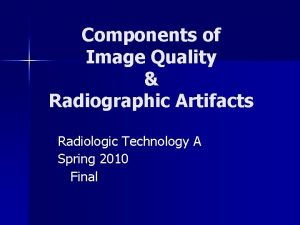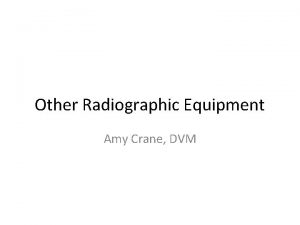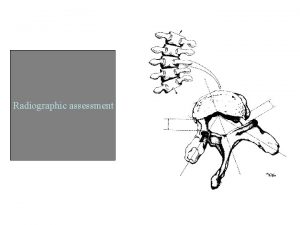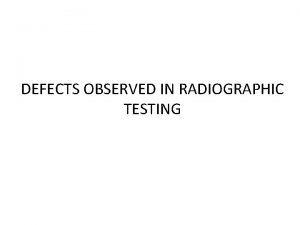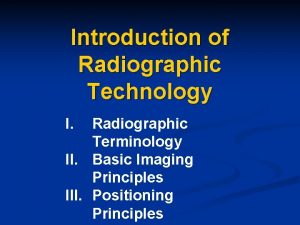Other Radiographic Equipment Amy Crane DVM In This



































- Slides: 35

Other Radiographic Equipment Amy Crane, DVM

In This Lecture ● ● ● Learn about x-ray beam limiting devices Learn about grids Know what a cassette is Know what intensifying screens are Know about film color sensitivity and why it is important

X-ray beam limiting devices ● ● Previously we stated that it was important to limit the size of the x-ray field There are two reasons for this -

X-ray beam limiting devices ● ● ● There are many devices used to accomplish this task of decreasing the size of the x-ray field Cones, cylinders, and aperture diaphragms have been used in the past Currently, the standard technology is the collimator

X-ray beam limiting devices ● ● ● Collimators allow a variety of x-ray field sizes Most systems use a mirror to align the light field Some portable systems use a laser to center the field

X-ray beam limiting devices ● ● ● Collimators do not focus the x-ray beam, they merely shape it by cutting off the edges of the beam. They simply exclude the part of the beam we don’t want to use Since x-rays do not have a mass or charge, they cannot be focused

X-ray beam limiting devices ● ● Collimators are not fool proof Mirrors can go out of whack A good maintenance schedule will evaluate the accuracy of the collimator light on a routine basis Quality control test? ? ?

Grids and scatter ● ● Good collimation will reduce scatter Tissue is, however, still exposed even though we limit the field – and scatter is produced. Anytime scatter hits the film, there is image degradation A grid is used to reduce scatter from hitting the film

Grids ● Grids should be used anytime a body part thicker than 10 cm is radiographed

Grids ● Grid Composition -Made of hundreds of alternating thin lead strips with aluminum or fiber interspacers

Grids ● Grid Basics -In most grids, the lead strips are angled to be in alignment with the primary x-ray beam -This type of grid is a focused grid -Remember, the primary beam is the part of the beam that we want to expose the film -Scatter, however, will not be aligned with the spaces in the grid and will be absorbed by the lead strips -Thus, scatter photons cannot hit the film because the grid absorbs them

Grids ● ● Grids are not perfect Some of the primary beam will hit the lead strips and be absorbed Therefore we have to account for this reduction in intensity of the primary x-ray beam when we select an exposure for a radiograph Not all grids are the same, so be sure you know the grid factor of your particular machine.

Grids ● Grids are described in terms: -Lines per inch: -Grid Ratio:

Grid Types • Parallel grids • Focused grids • Cross-hatched grids

Grids ● Grids are described in terms: -Bucky factor: -Focal range: Most grids are focused. This means that the lead strips are angled so that they are in alignment with the fan shape of the x-rays coming from the x-ray tube. These grids must be used at a precise distance from the x-ray tube to work properly. If they are used outside (too far away or too close) of the focal distance the dreaded grid cutoff occurs

Grids ● Grid Cutoff:

Grids ● Grid cutoff: -This results in greater than normal absorption of the primary x-ray beam -The resulting radiograph will be very light or underexposed -The worst type of cutoff is when the grid is placed upside down. The tube side is usually labeled on the grid.

Grids ● Grid Lines and Moving Grids -When grids are used properly you may see subtle images of the alternating lead strips and spacers in the radiograph -These lines are called grid lines -They are the unfortunate consequence of using a grid -They are very fine and not usually distracting

Grids ● ● Fortunately we have a way of making the lines disappear by moving the grid back and forth during exposure of the radiograph This is called a moving grid system or Potter Bucky Diaphragm

Grids ● Grid care: -Grids are fragile -If the lead strips get bent or warped it will produce artifacts that will degrade image quality -Store flat and handle gently -Instruct your equine patients that they should not kick or stand on the grids!

Cassettes ● Cassettes: -Rigid, light tight containers that hold the x-ray film and screens -The screens are permanently mounted in the cassettes -There are many sizes of cassettes available to match the commonly available sizes of film -Many cassettes have a rectangular lead block that covers one portion of the screen. This allows for imprint identification later prior to processing

Cassettes ● Cassettes serve two main purposes

Cassettes ● ● You need to take care of your cassettes Using a damaged cassette will result in a crummy radiograph due to: -Light leakage around the edges -Warping will hamper screen function because the screen will not be pressed tightly against the film

Screens ● Intensifying screens -In general, the sensitivity of x-ray film to x-rays is poor -X-rays can be used to expose film but it would take a lot of radiation and a very long time for most purposes -Intensifying screens are used to increase the efficiency of film exposure

Screens ● Intensifying Screens: -This increases efficiency because radiographic film is more sensitive to light than x-rays -They are called intensifying screens because they intensify the effect that x-rays have on radiographic film -The color of the light emitted is either blue or green light

Screens • • • Composition • Supporting base with a layer of fluorescent crystals • Crystal layer is coated with a protective layer Crystals emit visible light • Blue or green • When excited by x-rays • Small flashlights Screens are inside the cassette and in contact with the film

Screens • Types of crystals • Calcium tungstate • Rare earth series

Screens • • • Screen speed • Consequence of screen usage is amount of x-ray radiation needed to cause exposure is reduced • Film isn’t as sensitive to x-rays so it would take more radiation without screens Different speeds of screen • Slower speed uses higher m. As setting • Faster speed uses lower m. As setting What determines screen speed • Size of crystals • Thickness of crystal layer

Screens ● ● Basically, the more you have of a given phosphor, the faster the system will be However, using more phosphor will greatly decrease image detail

Screens ● Intensifying screen benefits -Intensifying screens vastly decrease the amount of radiation our patients and personnel receive -Another benefit of intensifying screens is that they enable us to use faster exposures -Intensifying screens also increase contrast

Screens ● Screens – putting theory into practice -You need to select a good balance between the speed of the screen and the detail you need for your particular application -Most screens are rare earth screens composed of phosphors from the rare-earth elements of the periodic table.

Screens FYI: Older screens used calcium tungstate as the phosphor. They are not as efficient as the rare earth crystals at converting x-rays to light. Therefore thick layers of phosphor and large phosphor particles were necessary (which decreases detail)

Cassettes and Screens ● ● ● Screen Maintenance Keep clean because dust and film accumulate on the screen which will reduce performance Clean with a commercially available screen cleaner or alcohol and a lint free cloth Cassettes should never be left open when not in use Screens wear out with age which decreases resolution and speed A high-speed five year old screen has roughly the same efficiency as a new, slower speed screen

The Screen System ● ● Screens don’t do anything by themselves, they need film So when you talk about screens you need to talk about film Fortunately we have a whole lecture on film!!! Keep in mind that one characteristic of x-ray film that must be considered when you purchase film is color sensitivity of the film

The Screen System ● ● ● X-ray films are only sensitive to one color of visible light But, different screens give off different colors of visible light Therefore, you must match the film color sensitivity to the light being emitted from the screen Older screens emit a ‘blue violet’ light and appropriate film was ‘blue light’ sensitive Newer rare earth screens emit ‘green’ light ad require ‘green’ sensitive film
 Mandible x ray positioning towne's
Mandible x ray positioning towne's Radiographic films
Radiographic films Dental radiography techniques ppt
Dental radiography techniques ppt Radiographic film
Radiographic film Barium meal position
Barium meal position Geometric unsharpness of margins in radiographic image
Geometric unsharpness of margins in radiographic image Orbital meatal baseline
Orbital meatal baseline Radiographic artifacts definition
Radiographic artifacts definition Off center grid error
Off center grid error Transhepatic cholangiography
Transhepatic cholangiography Oid in radiography
Oid in radiography Reverse towne projection uses
Reverse towne projection uses Dark room radiographic darkroom layout
Dark room radiographic darkroom layout Pdl space
Pdl space Humongous insurance
Humongous insurance Roger clemmons dvm
Roger clemmons dvm Speuter
Speuter Integrating type dvm
Integrating type dvm Dr tracy turner
Dr tracy turner Dvm valuation method
Dvm valuation method Sap business one support launchpad
Sap business one support launchpad Catherine m. brown, dvm
Catherine m. brown, dvm Wendy blount
Wendy blount Tick map
Tick map Roger clemmons dvm
Roger clemmons dvm Patrick sullivan dvm
Patrick sullivan dvm Roger clemmons dvm
Roger clemmons dvm Wendy blount
Wendy blount Roger clemmons dvm
Roger clemmons dvm Patricia joran nude
Patricia joran nude Wendy blount dvm
Wendy blount dvm Wendy blount dvm
Wendy blount dvm Jennifer hatcher dvm age
Jennifer hatcher dvm age Wendy blount dvm
Wendy blount dvm Other initiated other repair
Other initiated other repair Theme of a mystery of heroism
Theme of a mystery of heroism







